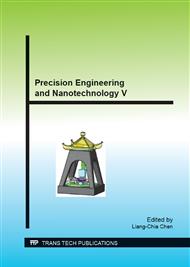p.258
p.262
p.267
p.274
p.282
p.288
p.297
p.305
p.310
Tool Wear Characteristics for Near-Dry Cutting of Inconel 718
Abstract:
In recent years, high-combustion-efficiency jet engines are required in the aircraft industry. Inconel 718, which has excellent mechanical and chemical characteristics. However, Inconel 718 is difficult to cut material because of its low-thermal conductivity. Consequently, Wet cutting is ordinarily adopted to reduce the heat on cutting heat edge in Inconel 718 cutting. Wet cutting which uses large amount of cutting fluid requires much cost and energy on maintenance or disposal of cutting fluid, and this method is environmentally-unfriendly. From the view point of reducing cost and environmental load, we examined the method of Near-Dry cutting which uses very small amount of cutting fluid for the cylindrical cutting of Inconel 718. However, this method has some problems, such as tool wear and cutting stock removal rate. In this report, we experimentally examined the relationship between cutting speed, tool materials, and tool fracture of near-dry cutting of Inconel 718. We compared these results with those of wet cutting, a method which is more expensive, requires significantly greater amounts of energy, and is less environment-friendly. The results indicate that when cutting speed is 100 m/min, tool fracture occurs at a cutting distance of 200 m. When cutting speed is 50 m/min, tool fracture does not occur and near-dry cutting distances can continue beyond 600 m. Moreover, tool wear could be reduced when S05 tool material, which has high bending strength, was used.
Info:
Periodical:
Pages:
282-287
Citation:
Online since:
August 2014
Authors:
Keywords:
Price:
Сopyright:
© 2015 Trans Tech Publications Ltd. All Rights Reserved
Share:
Citation:


